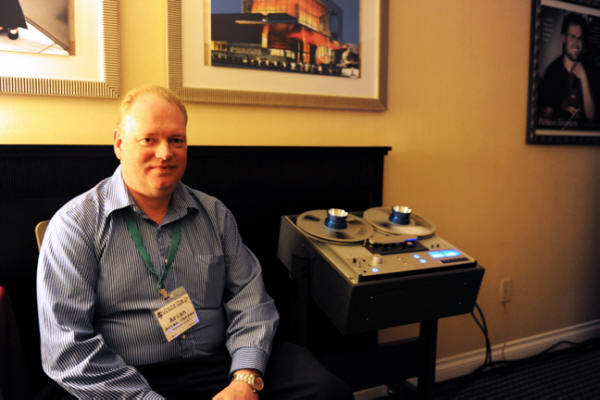|
You are reading the older HTML site
Positive Feedback ISSUE 61
The
Reel-to-Reel Movement: The SonoruS Holographic
Imaging Process
[Arian Jansen is President and CTO of SonoruS, a high-end audio company based in California. SonoruS produces an entire line of fine audio products, including a preamp, amps, planar speakers, and a beautiful analog 7.5/15 ips with switchable NAB/IEC half-track open reel machine based on the Revox PR99.Regarding Arian's qualifications, I quote from their Web site:
"Before starting SonoruS Audio in 2008 Arian Jansen
has held several senior management positions in the
electronics industry. Most recently he was Senior
Vice President of Engineering and Vice President of
Power Products at ICC/Elpac Electronics Inc.
responsible for all engineering activity at Elpac,
including leadership of design and product
development activities at its design centers in
Irvine, California and Shenzhen, China. Before
joining Elpac, he was Director of Advanced
Engineering at Flextronics, responsible for building
a power supply design team and supporting major
international customers. He has similar experience
building power supply design teams and introducing
new products incorporating new technologies as
Director of Development Engineering at Delta
Products Corporation (US subsidiary of Delta
Electronics Inc. of Taiwan) and as Director of R&D
at NMB Technologies. Previously he was a Senior
Engineer for Power at Hewlett Packard in Grenoble,
France. A native of The Netherlands, he speaks
English, German and Dutch. (See http://www.sonorusaudio.com/About_us.html). Jansen's article concerns his work with a fascinating process to improve the imaging of stereo, to allow for a more "holographic" presentation of a soundstage using stereo playback. Having heard the very impressive results of his system with a DSD multi-channel source file processed to 15 ips half-track open reel analog at THE Show Newport Beach 2012, I am publishing this article that Arian has submitted to PFO pro bono publico. I think that SonoruS is on to something here. Enjoy… and learn! Ye Olde Editor]
Arian Jansen, President and CTO of SonoruS, THE Show Newport Beach, 2012 (photograph and processing by David W. Robinson) The SonoruS Holographic Imaging Process is a real time, fully analog, acoustic 3D process that enables the listener to experience a true three dimensional sound field from a conventional two channel audio system. The current state of the process is the result of more than 20 years of R&D in the field of human hearing characteristics, audio reproduction systems, and most importantly, psychoacoustics. To start with the last point, audio reproduction from a limited number of discrete loudspeakers requires the creation of an illusion in order to get the perception of a sound field. In conventional stereo this illusion is created by differences in amplitude, phase, and time between the two loudspeakers, which is captured in the recording. However, the illusion of a homogeneous sound field coming from a conventional stereo set up, with instruments having their own place in a three dimensional space, is severely flawed. The result is that our brain will initially dismiss the illusion of an acoustic three-dimensional space, and will degrade the experience to music merely coming from two easy to localize loudspeakers. Still, when we listen to a stereo set up extensively, we can train our brain to dismiss many of the stereo-related flaws, so that we can start hearing the illusion of an acoustic three-dimensional space. As audio enthusiasts we have all been in the situation that we showed off our system to an untrained listener, pointing out the beautiful soundstage, and the untrained listener looks at you as if you have been sniffing glue. The untrained listener may appreciate the quality of the sound coming from the speakers, but in his or her experience it is merely coming from the loudspeakers. What soundstage? This problem gets worse with 5.1 systems, even for 'trained' two-channel listeners. The remark sometimes heard that many 5.1 systems sound like 5 channels of mono is indeed very true, and probably partly responsible for the diminishing interest of audio enthusiasts in multi-channel audio. In order to create a much better illusion, it is no longer acceptable that the brain has to do all the work of distinguishing between what is the correct information for the 3D sound field and what are the flaws. If the sound to your ears is the same for the illusion as it is for the real thing, your brain will perceive it as the real thing regardless whether you are a trained or untrained listener, because even an untrained listener is very trained and skilled in the perception of real, everyday sounds. The 'untrained listener' has proven to be a very valuable 'tool' in the development of the SonoruS Holographic Imaging Process. If a healthy untrained listener can't hear the 3D imaging, the process is simply wrong. In its simplest form, the SonoruS Holographic Imaging Process will take the two channels of an existing recording and compensate for a number of inherent shortcomings of conventional stereo reproduction. If the original recording is done well, an untrained listener will also hear the phantom imaging in the recording that can range to about + and -45 degrees from the centerline of the loudspeakers, for fairly common speaker placements of about + and -20 to 25 degrees. Also the perception of depth is significantly improved, and can range from a few feet in front of the speakers to many feet behind them. Even though the soundstage in the recording is now much easier to hear, there is still a significant part of a realistic concert experience missing. In the real world, the soundstage is not limited to +/-45 degrees, but envelopes the listener in the form of reflections on side and back walls of the concert venue, or in the form of actual discrete sounds coming from the sides and back, as is the case when being in the audience. To help in creating that illusion in a conventional set-up, most audio enthusiasts like to have an absorbing front wall to preserve the perception of depth, and a reflective back wall to get the perception of sound coming from the back. The drawback of such an approach is that it will try to squeeze the performance in the listening room, rather than transport the listener to the performance in its original venue. For recordings that include actual surround information, the full version of the SonoruS Holographic Imaging Process is capable of reproducing accurate phantom imaging from +120 degrees to -120 degrees for a speaker placement of +/-20 to 25 degrees, and as close as one foot from the listener to hundreds of feet away. Even though the capabilities of the SonoruS Holographic Imaging Process when used to its extremes can create a remarkably realistic illusion of objects moving around and behind you, the most interesting benefit is its ability to complete the real size acoustical ambience of the venue during a concert. Especially with large orchestral performances and operas, but also with live rock concerts, the SonoruS Holographic Imaging Process can transport the listener to the concert. Over the years, several processes have been developed to create a wide phantom imaging from two speakers, such as SRS surround, QSound, and Dolby Virtual Speaker. Some of these systems deliver on the promise to some extent; however, they all suffer from a major lack of realism. They all make use of the technical side of the human hearing characteristics in the form of HRTF (Head Related Transfer Functions), but they also all completely ignore the psychoacoustic side of it. The result is that the illusion only works for very simple sounds that sound very artificial and processed, while complex sound sources such as musical instruments have the tendency to smear over a large area (QSound), or fully break the illusion (SRS). Next to these phantom imaging problems, the earlier mentioned processes also cause a very significant distortion of the tonal balance of the musical instruments, which we consider an unacceptable compromise. Even though the SonoruS Holographic Imaging Process also makes use of some of the HRTFs, it also uses a process we have called 'Psycho Acoustic Association,' which keeps the phantom imaging accurately focused, coherent, and fully preserves the original tonal balance, even if it appears at 90 degrees from the listener and even if it is a complex sound source that contains some frequencies that the human hearing can technically not place in the three-dimensional space. Concerning the practical execution, the SonoruS Holographic Imaging Process can use up to eight channels of source material to recover the most detail from the original recording and put it back into two channels, preserving the full 3D sound field as well as the original tonal balance of the recording. The recovery and recombination process is real-time and fully analog, using hybrid (tubes and solid state) electronics, and consists of up to 16 parallel processing circuits with a very short audio path. The process uses a minimum of 2 and a maximum of 8 input channels, and produces a minimum of 6 and a maximum of 16 output channels that are then combined from 2 x 8 to 2 channels that can be reproduced over a conventional stereo system. In many cases the original source comes from hi-res digital such as DSD or 24/192 PCM. Each channel will in that case first be converted to analog before entering the SonoruS Holographic Imaging Process. Since the analog process doesn't use any rounding, and uses in many cases several of the input channels at the same time for some of the output channels, all 16 output channels contain at least the same or higher resolution than the original input channels. After combining 2 x 8 channels to 2 channels, the resolution of the result is actually a lot higher than the resolution of the individual input channels. Even though the 2 channel result can be recorded on any digital device, we are currently using analog tape to best preserve the holographic character of the results of the process. Since the output of the SonoruS Holographic Imaging Process is purely 2 channel, it can be played back on any conventional 2 channel audio system. For the best Holographic Imaging results, the process assumes a playback system that has substantially flat frequency, and phase and time delay characteristics between 100Hz and 10kHz. For the most realistic playback experience, the frequency characteristic of the playback system should obviously extend from less than 40Hz to more than 20kHz, but reasonable phase and time delay errors in the extremes of the frequency characteristics will not jeopardize the placement and focus of the phantom images. Unfortunately, there are quite some non-phase and time coherent speakers on the market at every conceivable price point. On the other hand there are also many speakers on the market that are correctly designed in those areas, and also at every price point. Excessive room reflections can also compromise the phase and time coherence of the playback system, even if the speakers are correctly designed. The source components and amplifiers are hardly ever an issue if it comes to phase and time coherence, with the exception of some tube power amplifier designs that exercise very little control over the speaker, and may cause major phase and time alignment errors in combination with the speaker. With a very large selection of well-recorded stereo material, and also a good selection of correctly executed multi-channel recordings, the SonoruS Holographic Imaging Process brings a substantial improvement in the perception of a realistic live concert experience from a 2 channel playback system. Especially with some of the very well recorded multi-channel material, both experienced and inexperienced listeners have stated that the results of the SonoruS Holographic Imaging Process are as close to a real live performance as they have ever heard.
SonoruS Audio
|


